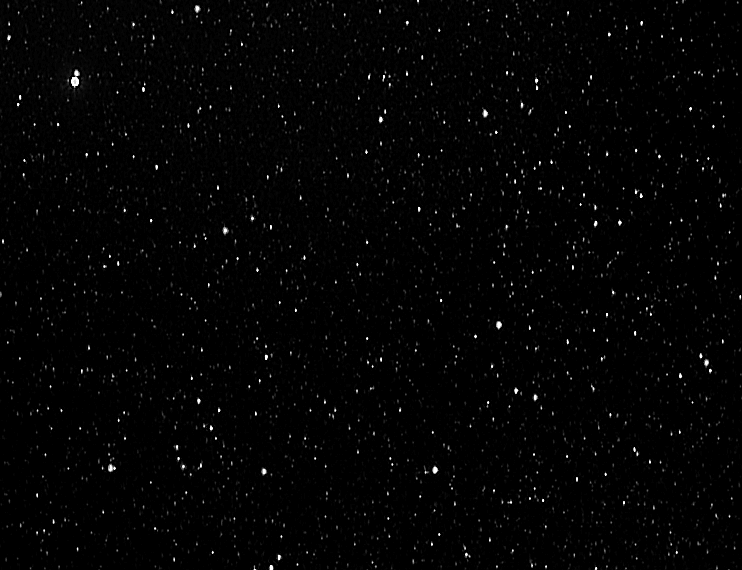

Ariadne is asteroid number 43. It was discovered by N. R. Pogson on 15th April 1857. It is the second largest of the Flora family (see Footnote) of asteroids (sometimes known as the Ariadne family since Flora's membership was called into doubt). Flora is the largest member of the family at 140 Km across and contains about 80% of the mass of the group, with Ariadne taking most of the rest. It is elongated, has an axial tilt of 105°, and subtends a similar angle to Pluto. It reached opposition on 13th January and ended its retrograde motion on 4th March. Its magnitude here is about 12.3.
 This was not a good time to detect this asteroid, but I have captured pictures on 4th, 6th, and 14th of March. There appear to be two moving objects in these pictures, although the third image of one of them is quite difficult to see. Move your mouse over the image to see the ones that I have identified. Ariadne is the faster-moving object. The picture covers an area of about 165×123 arc-minutes. The bright star in the upper, left-hand corner is Mekbuda, ζ-Geminorum and, in the third picture, I estimate that the object shown by the larger arrow is 59 arc-minutes (almost 1°) from Mekbuda. Cartes du Ceil gives the separation of Ariadne and ζ-Geminorum as 56' 44" on 14th March - an excellent agreement with my estimate. The corresponding distances on 4th March are 76' and 71' 56" respectively - another good agreement confirming my identification
This was not a good time to detect this asteroid, but I have captured pictures on 4th, 6th, and 14th of March. There appear to be two moving objects in these pictures, although the third image of one of them is quite difficult to see. Move your mouse over the image to see the ones that I have identified. Ariadne is the faster-moving object. The picture covers an area of about 165×123 arc-minutes. The bright star in the upper, left-hand corner is Mekbuda, ζ-Geminorum and, in the third picture, I estimate that the object shown by the larger arrow is 59 arc-minutes (almost 1°) from Mekbuda. Cartes du Ceil gives the separation of Ariadne and ζ-Geminorum as 56' 44" on 14th March - an excellent agreement with my estimate. The corresponding distances on 4th March are 76' and 71' 56" respectively - another good agreement confirming my identification
In addition to the second object indicated by the short arrows, I have spotted another two objects that appear in one or two frames but not all three. See my note below.
Date and Time: 4, 6, 14 March 2010 around 20:30 UT
Camera : Starlight Xpress MX716
Telescope: 135 mm SLR lens
Capture: Star_mx7: 20" exposure
Processing: Star_mx7. Dark subtraction, background, non-linear stretch, background.
K3CCDTools. 14 frames stacked, unsharp mask 3, 0, 100.
Note on secondary objects.
I can explain these extra apparent objects now. They are caused by hot pixels in the camera. (These are pixels which give a signal even when no light falls on them.) These are normally removed by subtracting a dark frame which is a frame captured with the lens covered so that no light reaches the camera, and indeed I did do this. However this removal is not perfect and in these cases a small residual signal remains. The pictures were then enhanced considerably by a function similar to a high positive gamma correction to bring up the fainter stars. Of cause this also enhanced the residual hot pixel. Since the three pictures were taken on different nights, I had to align my telescope as carefully as possible with the original so that the pictures were as near as possible the same. However this process was not perfect and the three pictures were finally aligned on the stars and so the hot pixel appeared to move giving a false asteroid. One reassuring aspect of this is that all those points of light which do not move really are stars and not defects in the camera. At the time Ariadne had a magnitude of about 12.5 and I have detected it quite easily despite my light-polluted skies.
Footnote.
A family of asteroids is a group with such similar orbital parameters (semi-axis major, eccentricity, inclination) that they are believed to have originated in the breakup of a single body. There are a number of such groups.
Home Back to This and That Back to Asteroids